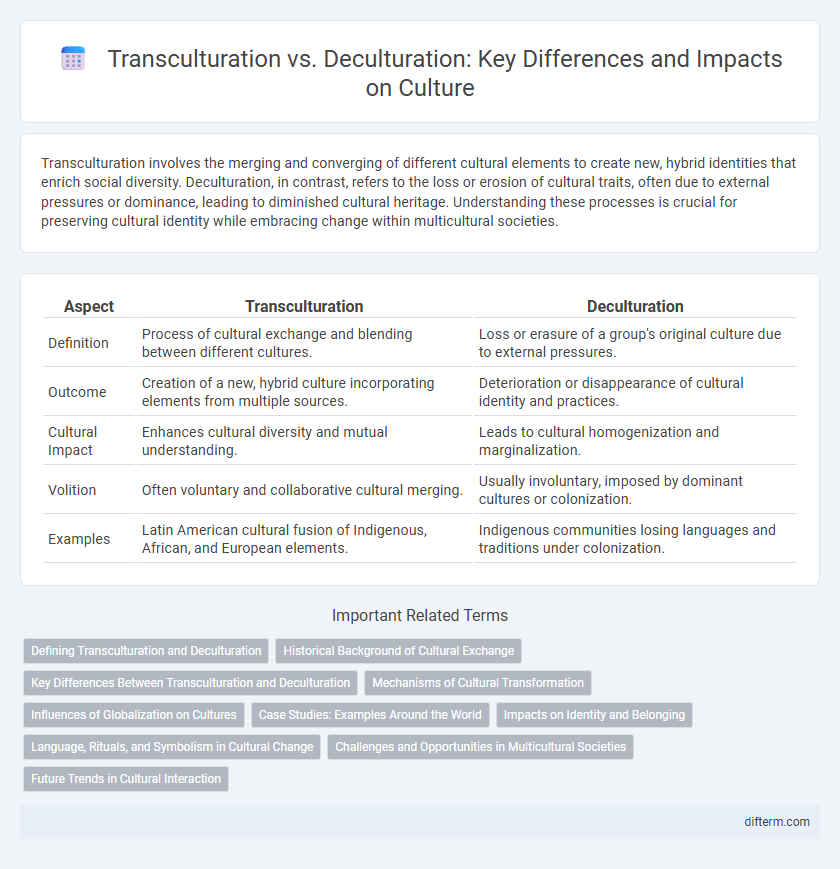Transculturation involves the merging and converging of different cultural elements to create new, hybrid identities that enrich social diversity. Deculturation, in contrast, refers to the loss or erosion of cultural traits, often due to external pressures or dominance, leading to diminished cultural heritage. Understanding these processes is crucial for preserving cultural identity while embracing change within multicultural societies.
Table of Comparison
| Aspect | Transculturation | Deculturation |
|---|---|---|
| Definition | Process of cultural exchange and blending between different cultures. | Loss or erasure of a group's original culture due to external pressures. |
| Outcome | Creation of a new, hybrid culture incorporating elements from multiple sources. | Deterioration or disappearance of cultural identity and practices. |
| Cultural Impact | Enhances cultural diversity and mutual understanding. | Leads to cultural homogenization and marginalization. |
| Volition | Often voluntary and collaborative cultural merging. | Usually involuntary, imposed by dominant cultures or colonization. |
| Examples | Latin American cultural fusion of Indigenous, African, and European elements. | Indigenous communities losing languages and traditions under colonization. |
Defining Transculturation and Deculturation
Transculturation refers to the process in which cultures merge and converge, resulting in the creation of new cultural expressions and identities through the exchange of values, beliefs, and practices. Deculturation involves the loss or abandonment of one's native culture, often due to external pressures such as colonization or globalization, leading to diminished cultural traits and traditions. Understanding these concepts highlights the dynamic interactions between cultural retention and transformation in multicultural societies.
Historical Background of Cultural Exchange
Transculturation emerges from the historical processes of cultural exchange where different societies engage in mutual transformation, adapting and blending elements from diverse cultural traditions. Deculturation, in contrast, often results from colonial or oppressive encounters that lead to the erosion or loss of indigenous cultural identity and practices. Both concepts trace their roots to periods of intense intercultural contact, such as colonialism, migration, and trade, highlighting complex dynamics between cultural retention, adaptation, and disintegration.
Key Differences Between Transculturation and Deculturation
Transculturation involves the exchange and merging of cultural elements between groups, resulting in the creation of new cultural forms, whereas deculturation refers to the loss or abandonment of cultural identity due to external pressures or assimilation. Transculturation emphasizes a dynamic, bidirectional process of cultural adaptation and innovation, while deculturation highlights cultural erosion and disintegration. Key distinctions lie in the outcomes: transculturation fosters cultural hybridity, whereas deculturation leads to cultural diminishment or erasure.
Mechanisms of Cultural Transformation
Transculturation involves the dynamic process where cultures interact, exchange, and merge, leading to the emergence of new cultural forms through negotiation and adaptation. Mechanisms include cultural borrowing, syncretism, and selective incorporation, enabling communities to blend traditions without complete cultural loss. In contrast, deculturation signifies the erosion or loss of cultural identity, often driven by external forces such as colonization or globalization, resulting in cultural disintegration and diminished heritage preservation.
Influences of Globalization on Cultures
Globalization fosters transculturation by facilitating the exchange and blending of cultural elements across borders, enriching societies with diverse traditions and practices. It also accelerates deculturation, as dominant global cultures often overshadow and diminish local customs and languages. The balance between transculturation and deculturation shapes contemporary cultural identities, reflecting complex interactions driven by economic, technological, and social global forces.
Case Studies: Examples Around the World
Transculturation is evident in the Cuban experience where African, Spanish, and Indigenous influences blend to create unique cultural expressions, such as Santeria and Afro-Cuban music. In contrast, deculturation is observed among Indigenous populations in Canada, where forced assimilation policies sought to erase native languages and traditions. Case studies from Brazil's quilombola communities reveal transculturation through the integration of African heritage with Portuguese colonial elements, while Native American boarding schools in the United States illustrate deculturation by systematically suppressing indigenous identities.
Impacts on Identity and Belonging
Transculturation fosters hybrid identities by blending elements from multiple cultures, enhancing a sense of belonging through shared cultural practices and values. Deculturation, conversely, often erodes traditional cultural foundations, leading to identity fragmentation and weakened community ties. The contrasting effects of these processes shape how individuals negotiate their cultural heritage and social inclusion.
Language, Rituals, and Symbolism in Cultural Change
Transculturation involves the blending and merging of languages, rituals, and symbols from multiple cultures, creating new hybrid expressions that enrich cultural identity. Deculturation, by contrast, entails the loss or suppression of original languages, rituals, and symbolism, often due to colonization or forced assimilation. Language shifts, ritual transformations, and symbolic reinterpretations serve as key indicators in distinguishing between transculturation processes and deculturative cultural erasure.
Challenges and Opportunities in Multicultural Societies
Transculturation in multicultural societies fosters dynamic cultural exchange, promoting diversity and innovation but also presenting challenges such as identity conflicts and social fragmentation. Deculturation risks cultural erosion and loss of heritage, yet it can create opportunities for new cultural syntheses and adaptive identities. Balancing preservation of cultural roots with openness to change is essential for social cohesion and sustainable multicultural development.
Future Trends in Cultural Interaction
Transculturation promotes the blending of diverse cultural elements, fostering innovation and mutual enrichment in global societies. Deculturation, marked by the loss or erosion of cultural identity, poses challenges to cultural preservation amid rapid globalization. Future trends indicate a growing emphasis on digital platforms facilitating transcultural exchanges while efforts to combat deculturation focus on safeguarding intangible cultural heritage through technology and policy.
Transculturation vs deculturation Infographic

 difterm.com
difterm.com